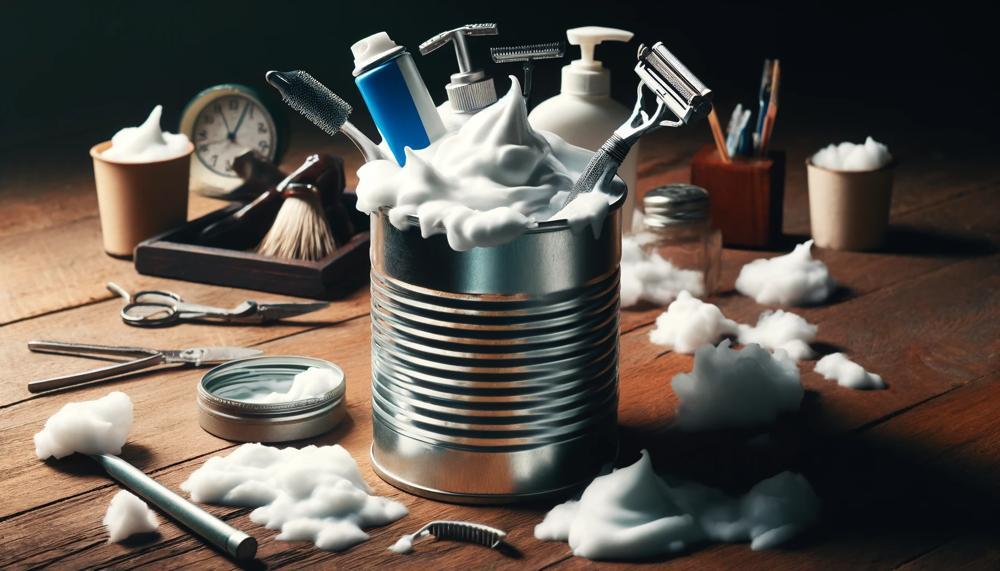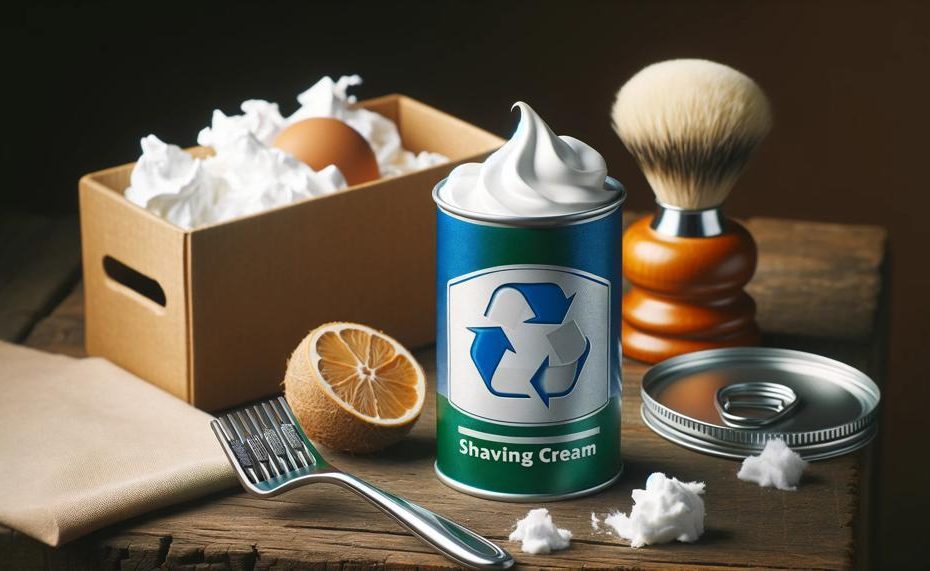Do you know that Americans discard about 18 billion disposable aerosol cans each year, including those for shaving cream? This staggering number paints a vivid picture of the potential environmental impact if not managed properly.
The journey to a more sustainable bathroom routine starts with small, conscientive steps, such as learning how to correctly dispose of your shaving cream cans.
Not only is this practice crucial for maintaining compliance with state recycling regulations, especially in places like Colorado and California, but it also plays a significant role in reducing our ecological footprint.
Here’s what you need to know to turn your routine disposal into an eco-friendly habit:
- Check the Empty Condition: Always ensure the shaving cream can is completely empty.
- Understand Local Rules: Contact your local recycling center to confirm their specific guidelines for aerosol can disposal.
- Direct Recycling: While the cans can generally be recycled, refrain from puncturing them as this can pose safety risks.
- Dispose Cautiously: If recycling isn’t an option, the cans should be emptied and depressurized before being thrown in the trash to avoid hazards.
- Handle Caps Separately: Caps should be removed and sorted according to your recycler’s instructions, typically into the plastics category.
This introduction serves as your guide to navigating the complexities of shaving cream can disposal with practical tips that ensure safety and environmental responsibility.
Let’s dive deeper into these practices and explore how simple changes in our daily routines can contribute significantly to planetary health.
Contents
How to Dispose of a Shaving Cream Can Via Recycling
Recycling shaving cream cans is a straightforward yet essential step towards environmental conservation. Here’s a guide to ensure you do it correctly and safely.
Ensure the Can is Empty
Before recycling, make sure your shaving cream can is completely devoid of any contents. Spray out all remaining cream to avoid complications during the recycling process.
Do Not Puncture the Can
It’s vital not to depressurize or puncture the can before recycling. This prevents any risk of explosion or fire, maintaining safety standards.
Cap and Sort
Separate the plastic cap from the can if applicable. The cap should be placed with other plastic recyclables, while the metal can goes into the metal recycling.
Local Recycling Rules
Check with your local recycling facility regarding the classification of aerosol cans. This will confirm whether your shaving cream can should be placed in a specific recycling bin.
Proper Disposal
Once confirmed empty and sorted, place the shaving cream can in the appropriate recycling bin. If in doubt, consult local guidelines or recycling centers for advice.
Tips for Recycling Shaving Cream Cans
For those aiming to recycle shaving cream cans effectively and foster a more environmentally friendly routine, here are strategic tips structured to enhance your recycling practices:
- Ensure the Can is Empty
- Completely use up the shaving cream to avoid pressure build-up inside the can, which poses risks during the recycling process.
- Check Local Recycling Guidelines
- Verify with your local recycling authority whether shaving cream cans are accepted. This varies by location and the materials they can process.
- Do Not Puncture or Alter the Can
- Leave the can intact; recycling centers prefer them unmodified to handle them safely and avoid contamination or explosive incidents.
- Prepare the Can for Recycling
- Remove any plastic caps and sort them into the plastic recycling if your facility requires this. Metal parts of the can should be left as is to be sorted at the recycling center.
- Proper Storage and Transportation
- Collect used shaving cream cans in a designated bin or bag to transport them safely to the recycling center or scrap metal facility.
- Consider Special Recycling Options
- If local recycling options are unavailable, seek out scrap metal centers that accept metal from aerosol cans.
- Promote Recycling Awareness
- Share information and encourage others in your community to recycle shaving cream cans, amplifying the impact on waste reduction.
To further clarify these tips, here’s a table summarizing the key points:
| Step | Action | Reason |
| Empty the Can | Use all the shaving cream. | Prevents pressure issues in recycling. |
| Local Guidelines | Check with local recycling. | Ensures proper processing. |
| Can Integrity | Do not puncture or modify. | Avoids hazards and contamination. |
| Sort Components | Separate plastic caps. | Facilitates correct recycling of materials. |
| Safe Storage | Store cans appropriately. | Reduces risk during transportation. |
| Alternative Recycling | Seek scrap metal centers. | Option if local recycling is unavailable. |
| Raise Awareness | Promote recycling practices. | Enhances community impact. |
Disposing of Your Shaving Cream Can in the Garbage
Proper disposal of shaving cream cans is not only a matter of tidying up but a crucial step in safeguarding our environment.
When recycling isn’t an option, disposing of these cans in the garbage must be done with care to avoid hazards.
Step-by-Step Guide to Disposing of a Shaving Cream Can:
| Step | Action | Reason |
| Empty the can | Press nozzle until no more contents come out | Prevents pressure build-up, making it safer to dispose |
| Detach parts | Remove cap and nozzle | Facilitates recycling of parts if possible |
| Rinse (if necessary) | Rinse can to clear out residue | Reduces the risk of chemical contamination |
| Local guidelines | Check with local waste management | Ensures compliance with regional disposal regulations |
| Garbage disposal | Place can in general trash | Final disposal if recycling not feasible |
By adhering to these guidelines, you contribute to a cleaner and safer environment, ensuring that potential hazards associated with improper disposal are mitigated.
Why Disposing of Your Shaving Cream Can Poorly is Dangerous

Why Disposing of Your Shaving Cream Can Poorly is Dangerous
Disposing of your shaving cream can inappropriately is fraught with risks, both to our environment and to our health.
The intricacies of these dangers are multifold:
Environmental Pollution:
Shaving cream cans, commonly crafted from aluminum or steel, resist degradation.
Buried in landfills, they linger for centuries, piling up as enduring waste. This mass accumulation contributes significantly to global pollution, tarnishing landscapes and harming ecosystems.
Health Hazards from Chemicals:
These cans encapsulate not only creams but also hazardous chemicals like propellants, preservatives, and fragrances. Improper disposal means these substances can infiltrate the soil and waterways, contaminating them.
Exposure to these chemicals is linked to respiratory issues, skin irritation, and in severe cases, cancer, posing a direct threat to human health and wildlife.
Risk of Explosions and Fires:
The pressurized gases within shaving cream cans, if punctured or heated, might ignite, leading to explosions or fires. This danger not only jeopardizes those handling the waste but also poses a broader threat to surrounding people and structures.
Air Pollution:
When disposed of in landfills without proper precautions, the trapped gases in these cans can seep out, contributing to air pollution.
This exacerbates environmental degradation and can have adverse effects on respiratory health.
Below is a table detailing the specific hazards related to the improper disposal of shaving cream cans:
| Hazard | Consequence | Impact |
| Environmental Pollution | Accumulation in landfills | Long-term ecosystem damage |
| Chemical Contamination | Leaching into soil and water | Health risks to humans and animals |
| Explosion Risk | Potential ignition of pressurized gases | Safety hazards to public and property |
| Air Pollution | Release of harmful gases | Increased respiratory diseases |
The cascading effects of these hazards underscore the paramount importance of adhering to proper disposal methods to mitigate these risks effectively.
Reusing a Shaving Cream Can
Rather than tossing out empty shaving cream cans, consider repurposing them in innovative ways. These robust containers, once cleaned and prepped, can serve multiple practical uses around your home.
Below, I’ve detailed a range of creative applications for repurposed shaving cream cans, ensuring they contribute value well beyond their initial purpose.
Crafty Containers
- Storage for Small Items: Transform a shaving cream can into a handy container for stashing screws, nails, or craft supplies. Their compact and durable design makes them ideal for organizing small, easily misplaced items.
Garden Gadgets
- Planters: With some holes drilled in the bottom for drainage, empty shaving cream cans can be repainted and used as quirky, unique planters for small herbs or succulents.
- Bird Feeders: By attaching a string and filling them with birdseed, these cans can be turned into functional bird feeders, adding a charming element to any garden.
Household Helpers
- Candle Holders: Shaving cream cans can be crafted into stylish candle holders. A few artistic touches, such as spray painting or decorating with fabrics, can integrate them beautifully into your home décor.
Safety and Preparation
- Preparation: Before repurposing, ensure the can is completely empty and clean. Avoid puncturing the can, and wear protective gloves during handling.
- Adherence to Local Regulations: Familiarize yourself with local recycling and disposal regulations to ensure your repurposing efforts are in compliance.
| Item | Purpose | Preparation |
| Storage Container | Organizing small items like screws, nails | Clean thoroughly, remove labels |
| Planter | Growing small plants | Drill drainage holes, paint as desired |
| Bird Feeder | Feeding birds | Secure with string, fill with birdseed |
| Candle Holder | Decorative light source | Decorate, ensure it’s stable for safety |
By repurposing your shaving cream cans, not only do you contribute to waste reduction but also enhance your home’s functionality and aesthetic.
What Happens to Recycled Shaving Cream Cans
Shaving cream cans are commonly made from steel or aluminum, both of which are highly recyclable materials.
The process of recycling these cans involves several steps to ensure they are reprocessed efficiently and safely. Here’s how it works:
- Emptying the Can: It’s essential to ensure the can is completely empty before recycling. This helps prevent any potential hazards during the recycling process.
- Sorting: Shaving cream cans should be sorted into the correct recycling category. This is typically metals, but check with your local recycling program for specific guidelines.
- Recycling Facility: Once collected, the cans are sent to a recycling facility where they are further sorted and cleaned.
- Processing: At the facility, any non-metal parts such as plastic caps and rubber valves are removed. The metal is then melted down and reformed into new products.
- Rebirth: The recycled metal can be used to produce new cans or other metal items, reducing the need for virgin materials and minimizing environmental impact.
To ensure proper disposal and recycling of shaving cream cans, follow these practical steps:
- Check Local Guidelines: Always adhere to your local recycling program’s rules, as these can vary by region.
- Don’t Puncture or Depressurize: Contrary to some beliefs, it’s unnecessary and potentially unsafe to puncture or depressurize the cans before recycling.
- Sort Correctly: Make sure to remove any plastic components and sort them separately if required.
Here’s a table that outlines key points to keep in mind for recycling shaving cream cans:
| Step | Action | Reason |
| Empty the can | Ensure the can is fully emptied of its contents | Prevents hazards during recycling and ensures can is processed efficiently |
| Sort components | Remove and sort non-metal parts like plastic caps | Facilitates proper recycling and correct handling of different materials |
| Follow local guidelines | Adhere to specific local recycling rules | Ensures compliance with local regulations and maximizes recycling efficiency |
Conclusion
As we uncover the astounding fact that Americans throw away approximately 18 billion aerosol cans annually, the importance of responsible disposal becomes unmistakable. Among these, shaving cream cans are prominent, highlighting a clear path towards minimizing our ecological footprint through correct recycling practices.
Proper disposal of shaving cream cans is not merely a routine chore; it’s an impactful environmental safeguard. By ensuring that each can is completely emptied and unpressurized, we prevent hazardous outcomes and facilitate effective recycling. It’s essential to remove any detachable parts, like plastic caps, and sort them as directed by local recycling facilities. This meticulous separation not only complies with specific recycling regulations prevalent in states such as Colorado and California but also fosters a recycling-friendly community.
Encouragingly, this process does more than just reduce landfill waste. It conserves energy and resources by redirecting materials back into the manufacturing stream, demonstrating a cycle of sustainability that benefits all.
Let’s embrace these small but mighty steps in our daily routines to make a significant difference—turning the simple act of disposing of a shaving cream can into a potent act of environmental stewardship.





